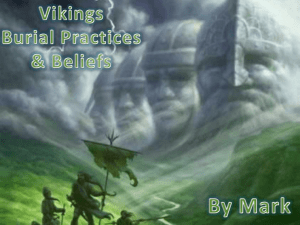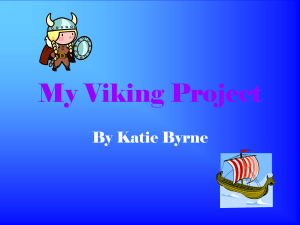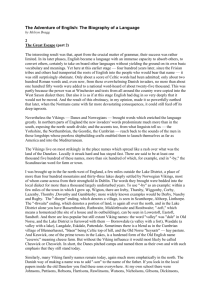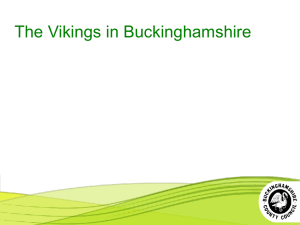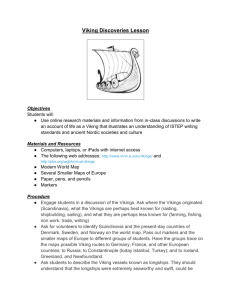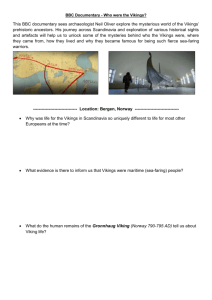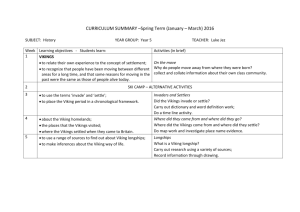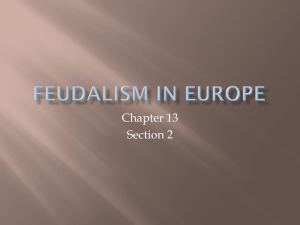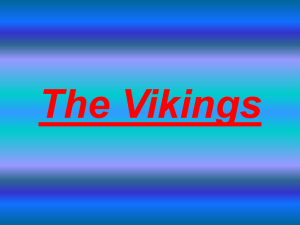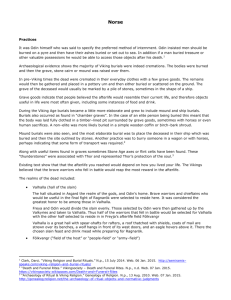Chapter 1. Dwelling into the Viking Mist - Academic
advertisement
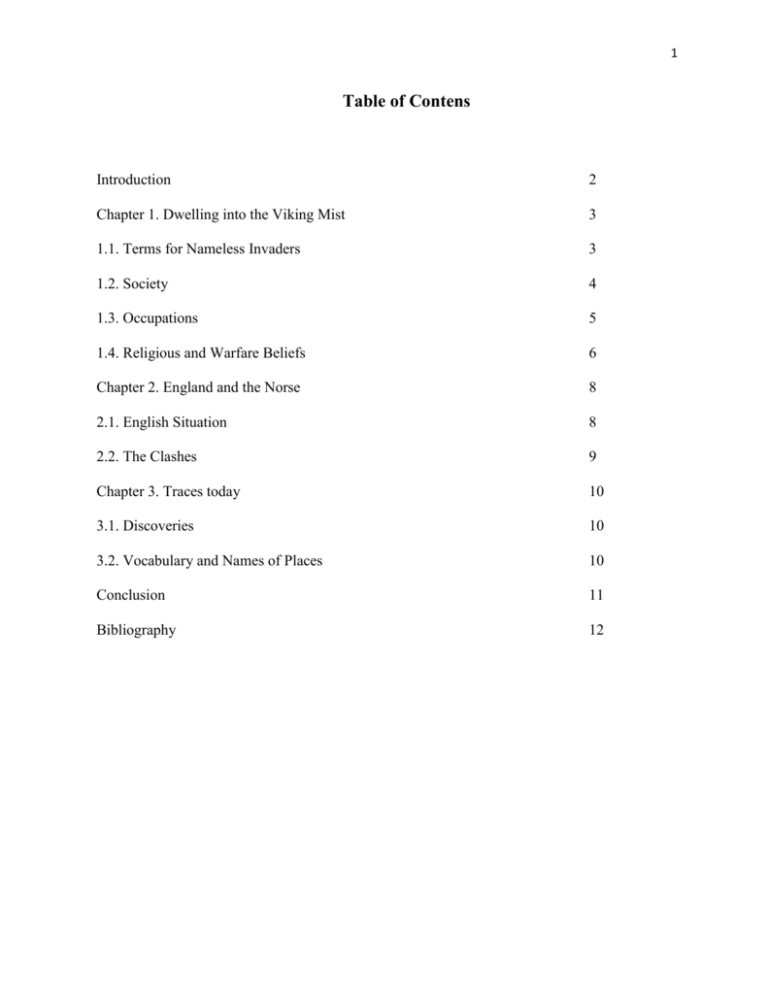
1 Table of Contens Introduction 2 Chapter 1. Dwelling into the Viking Mist 3 1.1. Terms for Nameless Invaders 3 1.2. Society 4 1.3. Occupations 5 1.4. Religious and Warfare Beliefs 6 Chapter 2. England and the Norse 8 2.1. English Situation 8 2.2. The Clashes 9 Chapter 3. Traces today 10 3.1. Discoveries 10 3.2. Vocabulary and Names of Places 10 Conclusion 11 Bibliography 12 2 Introduction In order to get to Valhalla, the Vikings were to die in battle, and for that purpose they waged war. For the ruled, that might have been difficult to accept, but marks and legacies are still present nonetheless. This paper discusses the Vikings – who they were, their origin, culture, beliefs, actions – and their influence on Great Britain, with the main focus being on the Scandinavians. The Vikings were a people that originated in the Scandinavian Peninsula. Such fearsome warriors, they gave the Viking Age (roughly AD 800 – 1050) its name. They emerged from the cold lands of the North and began to pillage, plunder, colonize and settle in new lands. While it is true that they conquered much and their domain was vast, the expansion was stopped eventually and the invaders repelled, but the ways of the foreigners were deeply intermingled with those of the natives. The part that is not known by everyone, however, is that these people were not the ruthless barbarians they are generally believed to be. The followers of Odin showed great battle prowess in all combat aspects. Their spears flew through the enemy with pinpoint accuracy and insane strength, often shattering armor like it was cardboard. The melee range was their specialty however. Charging like battering rams, the Norse trampled most enemies with shield and sword in hand. The weapon that etched their frightening appearence in history was, surprisingly, neither the spear nor the sword, but the humongous warhammer, wielded by the strongest only. So great that it had to be held across one’s shoulders with one hand when not in combat and swung with both when attacking, it was its groundshaking effect that became the trademark of the Vikings. 3 Chapter 1. Dwelling into the Viking Mist 1.1. Terms for Nameless Invaders According to Julian Richard’s “The Vikings – A Very Short Introduction”, the term “Viking” itself is of English origin, with the newcomers receiving a different name in almost every land, derived either from their religion or the apparent lack of it, or from their occupation. Some of these (translated) terms are “pagans, heathens, robbers, foreigners, Northmanni, Dani, pirates, fishermen”(5). However they have been, more often than not, used inaccurately and without regard to the actual origin or knowledge of the beliefs of the Scandinavian group in question. For example, the term “Viking” only describes the first two social classes (which will be explained later), actually, because it refers to the ones that battled the seas. They would leave each early spring and return late into the summer. The arrival of autumn and the coming of the icy winters of the north made it impossible for the men to cross the water, so they would stay in their village. 4 1.2. Society In the early days, the Vikings were divided, even though they might have seemed united to the untrained eye. They fought for their small patch of land, under the command of a ruler. As such, they distinguished themselves from others by labeling their group as “men of Vestfold” (Richards 3), for example. Initial group, meaning the exact, provenance was no longer important, because now they had the land and their leader. The mistaken belief of union surfaced because of the assumptions of outsiders. The Northern folk spoke the same language, Old Norse, as the linguists call it, shared beliefs and attire. Beyond that, almost nothing, as they often came in small waves, based on position or how fast the word regarding riches got to them. They have undoubtedly earned their reputation as great seafarers, even in small numbers. When they were not running the coastlands through sword and spear, their iron-ruled northern villages welcomed their strong. Back then, “society”, in their vision, consisted of three main classes, like most old peers. There was, of course, nobility. “Boendr” being its name, and the class included only the most influential and wealthy, namely the landlords. Lorry Brown claims in her article that “boendr” literally means “stay in one place” and refers to the farm owner (1). They were an incredibly independent class, as they had no overseer. Another class was formed out of workers, carpenters, fishermen and farmers, called the “Freemen”. This was the bulk of the northern folk. The last class is called “trells”, word generally used to describe slaves. These people were at the bottom of the hierarchy, their value was the same as that of a domestic animal and they were treated as such. Killing one’s own was allowed, killing another’s meant only that another had to be bought with the murderer’s money. The Viking society ruled itself. They had no written laws, just a “lovsigemann”. The function implied reading laws and opening the assembly, the “Thing”, a gathering with 5 legislative and executive power. In a sense, it was a more democratic system than the gathering of Athens, because in Greece, only approximately 10% of the citizens participated. The laws were memorized and not read, however, so that none could modify them (Hauge 1). The only categories that were not protected were the slaves, who had no value to begin with, and the outcasts, the exiled. Another distinction was made between men and women, though not related to laws, but to occupation. A woman was to stay home, tend to the family when injured (which implied a certain level of knowledge regarding herbal remedies), sees to it that the house remained clean and supplied. Also, she was never truly considered a member of the man’s family, but part of her own, her parents’. As such, all she needed for what we call a divorce were witnesses to acknowledge their incompatibility for any reason. 1.3. Occupations In those times, a hereditary system was still working in the north. The son would take over the family business and carry on with it. It did not matter what social class one belonged to, as slave children remained slaves, merchants gave birth to merchants, traders produced other traders, craftsmen would pass everything on and farmers left their lifelong work in the care of sons. Fishing was an activity they all practiced due to their geographical position. The folk were also known for their unique woodworking, the swift beast-shaped boats became a frightening sight for foes. 6 In times of war, however, only the ones needed to supply the troops stayed in their workshops, booths or on their usual routes. Every able man, regardless of purpose in society was to fight the oncoming hordes of the enemies. 1.4. Religious and Warfare Beliefs The folk guided themselves after an unwritten moral code and by ethics. One’s honor was valued above all else. The ideal Viking man was moderate, brave, generous but not careless with his gold, willing to help friends in need and to fight their enemies if necessary. Because of the custom of living as part of an extended family, one had to be very careful not to dishonor himself in any way because that would bring disgrace to the whole family. A peoples of warriors, they had a way to regain one’s life back, for living in disgrace was no living for a Viking. The dishonored one would be able to claim his victory by striking at any given moment, regardless of times. A common strategy was to wait for long periods of time before striking, and sometimes it took years, but, finally, the opponent lowered their guard and the punitive strike would come without the slightest hint of doubt or hesitation. The Scandinavians were pagans, they held a polytheistic religion, with Odin as the King of all. Legends speak of Odin as having had the habit of roaming the lands of Midgar in human disguise and impregnating various women, which is why many mortals could trace their origins back to him. His children were numerous and watched over many things in the world of lesser beings. Out of these children the most known is Thor, the god of thunder. Other gods are less known, but one important to mention is Loki, the “Wizard of Lies”. He would play pranks, cheat, and make fun of everyone and everything. 7 The most striking characteristic when it comes to religion was, undoubtedly, their belief regarding death. It was not feared, but welcomed, with one condition. In their ways, the honorbound life must be followed by honor-bound death, meaning one would have to die fighting on the battlefield and not in any other way. Only then would the hero’s spirit be allowed entrance in the Hall of Heroes, Valhalla. They looked at the fierce, bloody battles and saw a way of life. According to them, Odin could aid them in battle, empowering them, crushing their foes from afar. Him, and him alone would decide the day they are ready to enter the massive gates. Once that day arrived and the soldier fell in battle, the so-called “angels of the soldiers” came to take them to their destination. These maidens are called Valkyries, and have been depicted in black, white, gray and a number of other colors. Legend has it that they are the wayfarers to Valhalla, or “Valhöll” in Old Norse. The hall itself is thought to have 540 doors and a roof made of shields. 8 Chapter 2. England and the Norse 2.1. English Situation Back in the early centuries, England was just a congregation of small kingdoms, each of them just Christianized. Seeing as how the average man believed in God very much at the time, even blindly, some would say, it was very easy for the clerics to coerce people into giving money to the institution of the Church in exchange for God’s favor. This made the monasteries seem like easy targets, centers of wealth, and they were the first and most raided. Furthermore, until the rise of Wessex in the 9th century, the army was weak, scattered, outnumbered, unprepared. Without unification there was no hope of any kind of victory. This was only a small step though, as a true unification was not achieved until the 10 th century. The Vikings, even though they came in small waves because they were not united themselves back then, their battles were easy. The islanders’ economical situation was not great either. Of course there were some kingdoms which were wealthy because they were formed around a significant resource pile or 9 just because they got lucky, but others were struggling to survive, and that too, was very detrimental for the English as a nation. 2.2. The clashes Most sources found state that, as was to be expected, one of the bloodiest raids that may have been the first one as well, took place along the coastline in 793 A.D. and the Lindisfarne monastery was ran through steel and looted. The Vikings continued to roam through English land until the battle at Edington, when king Alfred of Wessex fought the Viking ‘Great Army’ and crippled the bulk of the force, now more united. The northern and eastern counties were given to the Viking settlers, who merged with the local population, turning towns like Lincoln, York or Nottingham into important Scandinavian strongholds. There were many small battles, but the last major one was at Stamford Bridge, near York in 1066. 10 Chapter 3: Traces today 3.1. Discoveries A significant amount of Viking artifacts were found all over their former lands. In England, one of the most important discoveries was a mass grave. Later proven to be the remains of a camp, it was discovered at Repton and it is believed that the raiders spent the 873 – 874 winter there. The persons buried are thought to have died of disease, seeing as how there were no battle wounds. Approximately 249, the pattern in which they were laid suggests an important person being there with them, although added later to the common grave. In January 2007, at a small farm in England, a nearly 1 million dollar discovery was made. A small, silver bowl and treasure trove were found, along with gold coins and jewelry. 3.2. Vocabulary and Names of Places Because of the fact that Old English and Old Norse shared the same Germanic ancestry, it can sometimes be hard to track the origins of a word and historians argue endlessly. This is due to the fact that there is a great spread of Viking names of places. There are two main sides to this argument, one that claims that Viking was adopted as a language by the English and one that says the invasion involved a lot of people. We know very little about t if a place name ends in “–by”, than it generally means that the Vikings first settled there, and if we follow this claim, we find over 200 settlements in Yorkshire alone. Then there are the places with names ending in “-thorpe”, places connected to the second wave of settlers and concerning settlement that were positioned on the coastline or on very poor land. 11 Conclusion The clash between cultures was indeed fierce, and undoubtedly the foreigners’ religion and beliefs had a great role in their actions, but the perspective of the participants on each other could not have been more different. To the English, the Vikings were peoples of invaders that fought them and drove them from their homes. From the other side, the English are very likely to have been a mere stepping stone at first, only after that becoming a place to settle, at least in Northern eyes. Valhalla was nothing to them, and they did not know Odin. The differences are still pregnant in small areas, but as time passes, their legacy will vanish slowly, like any other. In the end, the Vikings came like a horned bearst, fearsome because of its might, but mostly because of its aura, a new unknown, presence. What man fears most is death, darkness, and that is because of they apparent power, because no one truly knows what lies beyond. It was the same with the Norse, the Valkyries that surrounded them and their welcoming of the Beyond. What made them so terrifying a foe was this aspect, more than any other one characteristic of their varied sphere. They would ravage through hordes of soldiers, seeking eternal glory and passage into the realm of gods, Aasgard. The lies Valhalla, “the hall of the slain”, where they were to banquet and rest untill the end of time, as a reward for their everlasting battle. Shields their cover, weapons in hand, their skills intact, they watched over their brethren, often pleading with Odin to render aid. The Viking beast was eventually defeated, but not slain. Pushed back to its lair, it srayed strong and endured the corrosive effect of time, and lives today within the children of the Norse. It was not until its clutches were deeply in foreign land that the cage was closed around it. Remnants are everywhere, be it England, the Scandinavian Peinsula or other lands. 12 Bibliography Brown, Lorri. “Viking Society”. Web site. 14.03.2011. http://www.suite101.com/content/viking-society-a121645 Gauge, Arild. “Daily life in the Viking Society”. Web site. 14.03.2011. http://www.arild-hauge.com/elife.htm Mikliz, Franz, “Port Valhalla” (Illustration). Web site. 24.03.2011 http://www.epilogue.net/cgi/database/art/view.pl?id=55003 Multiple Anonymous Authors. “The Viking Network”. Web site. 14.03.2011. http://www.viking.no/e/travels/etrade.htm Richards, Julien. The Vikings – A short introduction. E-Book. Shades. “Valhalla”.Web site. 14.03.2011. http://www.angelfire.com/realm/shades/vikings/valhalla.htm
